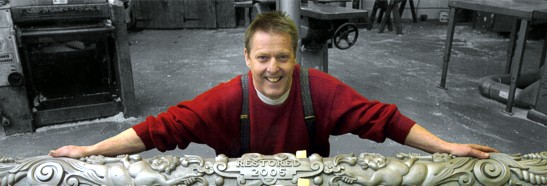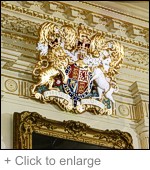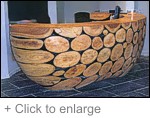|
About

Robert Lewis was born in 1957 in
West Kirby in the Wirral. His
first recollection of an
interest in woodwork was coming
across an old biscuit tin
containing carved
puppet/marionette limbs and
torsos in his grandfather’s
garage. Having travelled with
his father in the Royal Air
Force, the family eventually
settled in Suffolk where at the
age of seventeen Robert was
offered an apprenticeship as a
woodcarver with Titchmarsh &
Goodwin in Ipswich.
In 1981 Robert decided to work
for himself in a bid to expand
the variety of carving and to
utilise his skills with more
technically demanding projects.
|
During the mid eighties Robert
was invited to tender for the
restoration and refurbishment of
No.10 Downing Street.
The sheer
amount of architectural carving
involved deemed it necessary for
several woodcarvers to be
involved.
At the end of the
project Robert was invited to
carve the Royal Arms
(approximately one metre square)
which now adorns one of the
State Rooms and is one of his
most favourite commissions to
date. |
|
 |
Other projects have included:-
Uppark House, Hampshire:
finely carved acanthus leaf
pelmets, swags and various
mouldings – all in lime.
Windsor Castle: tracery
work on the staircase in St.
George’s Chapel.
Brentwood Cathedral:
Corinthian capitals in the round
and square, carved in softwood
for gilding. Large brackets with
honeysuckle motif, again in
softwood for painting.
Danesfield House, Marlow:
decorating the new hammer beam
ceiling, cornucopias, leaf work,
cherubs, dragons, dolphins – all
in oak.
Foreign Office, London:
oak architraves and door
surrounds, large heavily carved
and pierced brackets.
St. Mary’s Church, New York:
screens containing oak leaves,
grape vine motif, various
animals and insects – all in
lime for painting.
House of Commons, London:
restoration of damaged oak
crowns and heraldic shields,
Globe Theatre, London:
Ionic capitals above the heads
of Tragedy and Comedy statues.
Abacus on top of Corinthian
capitals on main stage.
St. Paul’s, Deptford, London:
restoration of finely carved
pulpit, serpentine panels with
pierced surround of leaf work,
marquetry faced and large
pierced brackets. Rumour has it
that the pulpit may have been
the work of a student of the
master himself, Grinling
Gibbons.
Assembly Rooms, Norwich:
from a collection of salvaged
remains the restoration, where
possible, and the carving of new
Ionic capitals.
The Vintners’ Company, London:
an ongoing restoration project
during the closed period, of the
vast amount of carving on site.
The Board Room at Five Kings’
House has some of the finest
carving to be seen.
Cabmans’ Shelter, Ipswich:
closer to home, this beautiful
building was, as the name
suggests, a shelter for the
cabmen of Ipswich. Constructed
in 1892, it was moved from the
town centre to Christchurch Park
a mile away. In the 1990s it was
set alight and almost totally
destroyed. However, just enough
detail remained to make new
drawings. The carving consists
of dragons, cherubs,
cornucopias, acanthus leaves,
foliage, leaf work and various
beasts.
In contrast to much of the above
Robert has undertaken regular
commissions of extremely small
and detailed carvings for
pattern making and castings in
bronze or brass.
Robert has also designed and
carved several village signs, a
fine example of which can be
seen in the village of Hengrave,
Suffolk, completed in 2006. He
has also a great deal of
experience in furniture
restoration.
|
Robert’s most recent commission
was for a reception desk made
from sweet chestnut logs.
On completion it weighed
approximately 1.5 tonnes and
involved shaping with a chain
saw!
The finished curves and
lines are quite spectacular as
this picture shows. |
|
 |
Robert welcomes the opportunity
to discuss enquiries and
commissions on any scale and can
be contacted as above.
|